-
Posts
796 -
Joined
-
Last visited
Content Type
Profiles
Forums
Gallery
Events
Posts posted by robdurant
-
-
And now it's daylight, some better photos...
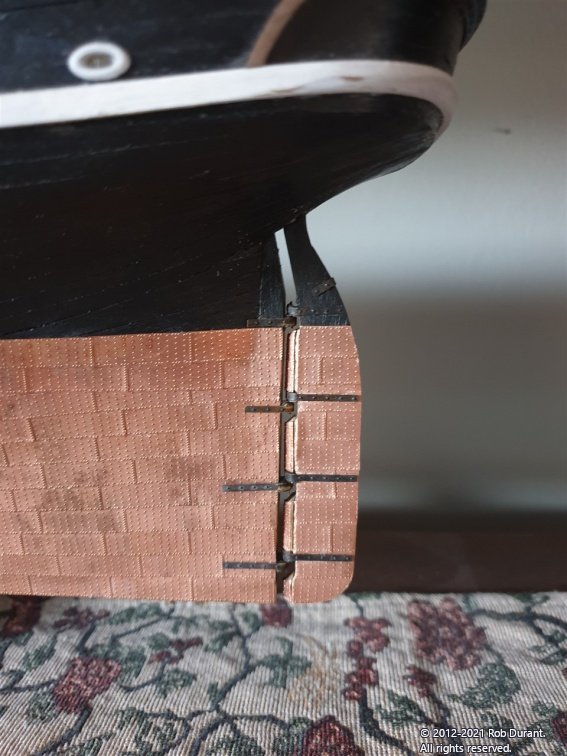
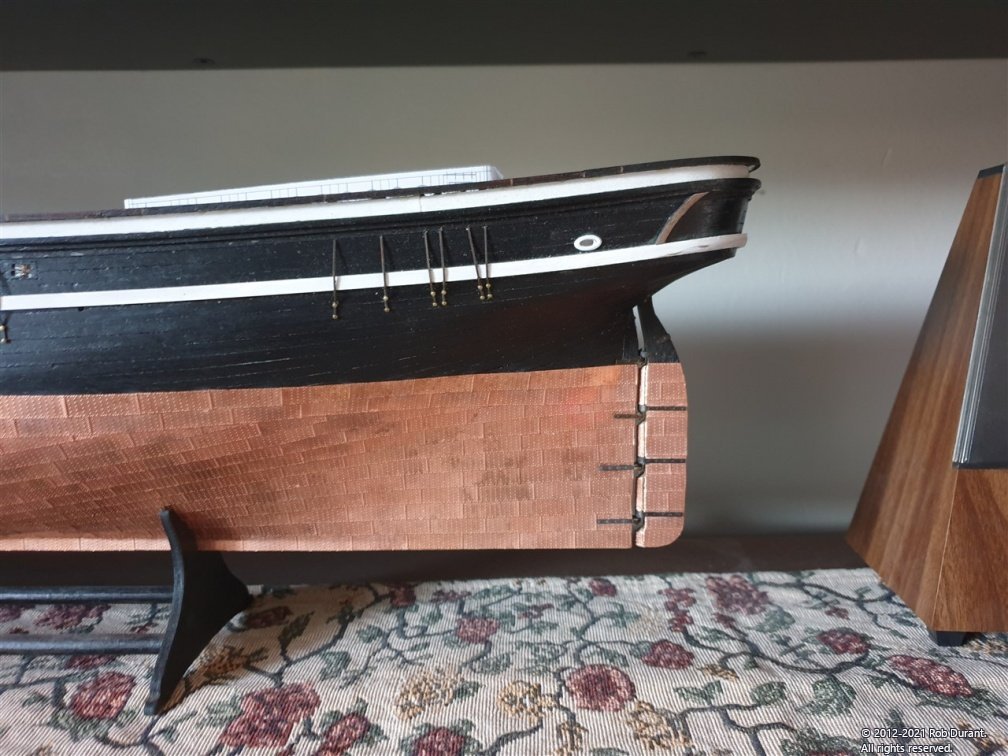

- Overworked724, coxswain, Rudolf and 5 others
-
 8
8
-
Okay - more work on hanging the rudder...
I test fitted the rudder with the pintles and gudgeons in place, and it quickly became apparent that there was going to be a massive gap between the rudder and the hull.
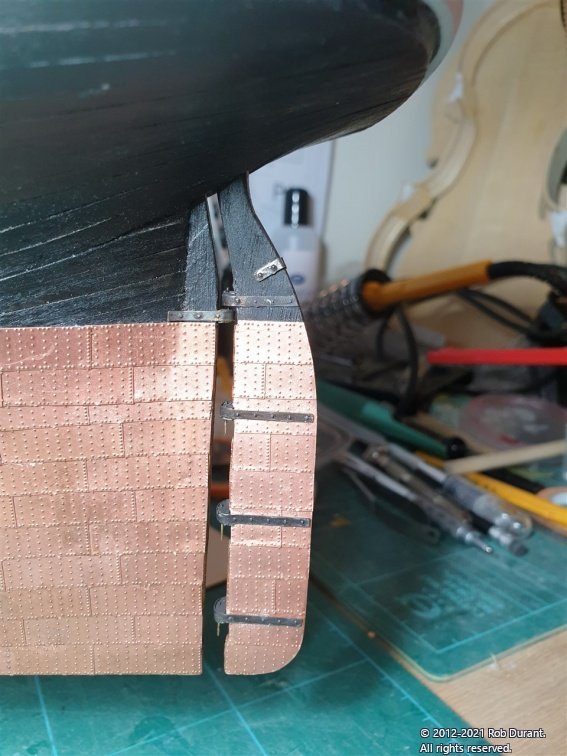
I wasn't happy with that gap at all... but equally I didn't really want to start over, and I wanted to try and use the photo-etch pintles and gudgeons if I could, because they're really nice and sturdy.
I put my thinking cap on, and it occurred to me that a big part of the problem was that the rudder didn't extend very far out towards the forward extend of the pintles... so I decided to increase the size of the angled section at the front of the rudder. I used the walnut from the laser-etched sheet that I took the rudder from, and created a triangular cross-section that I could then use in between the pintles.
In the photo below I've only fitted the top section. The remaining section is behind the rudder with the next part already cut and bevelled at the top.

The net result is shown below...
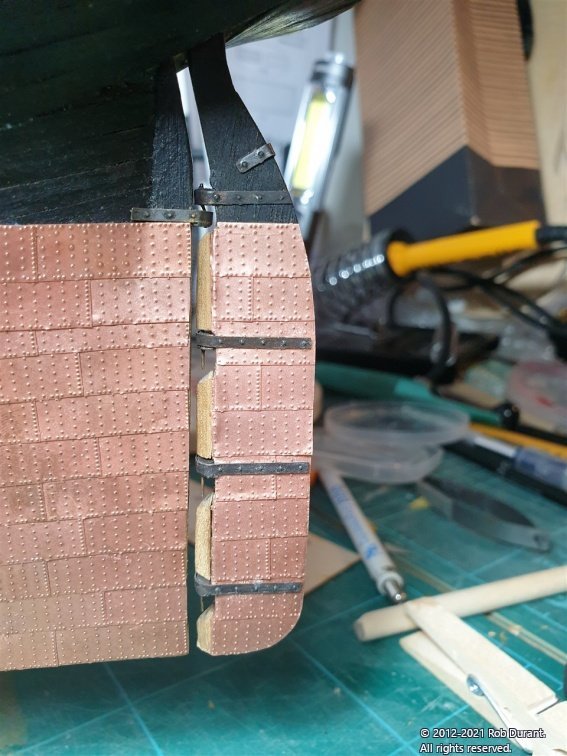
Then I covered the extra sections with copper tiles.
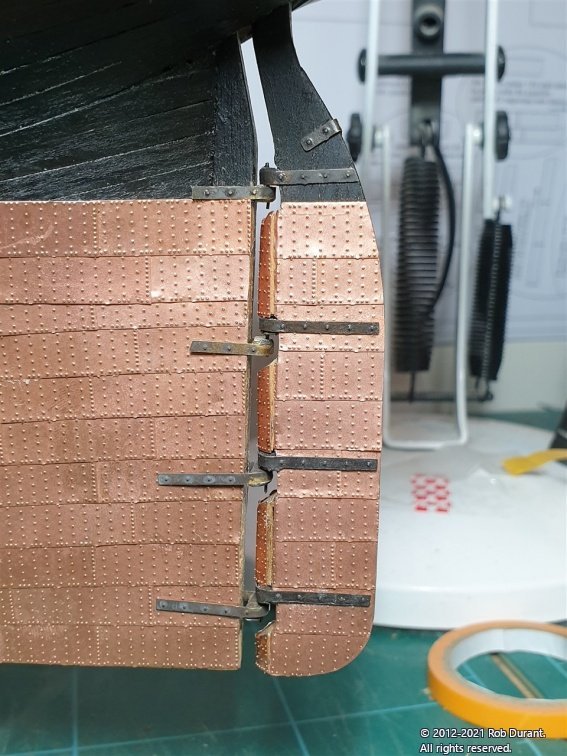
Having taken this photo, I then opened out the hole in the hull that the rudder passes through to allow the bottom of the rudder to swing forward a little more.
Here's the before and after (still dry-fitted)...
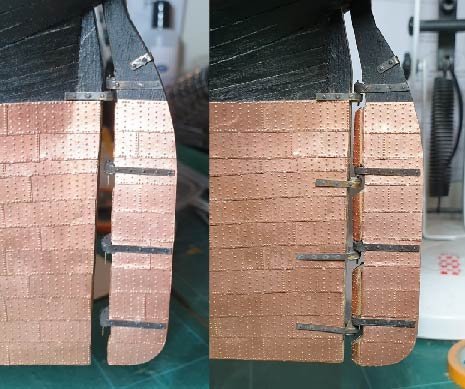
It's not perfect, but I'm much happier with the gap. There's a bit of touching up to do and it all needs to be fixed in place, but if I were starting out all over again, I'd definitely do a lot more to the shape of the rudder first of all to make sure I avoided this re-working.
That's it for this evening. Thanks for the likes, and happy building to you all.
Rob
- Keith Black, coxswain, gsdpic and 3 others
-
 6
6
-
Hi all,
Thanks very much for the likes.
A little more progress to report. I've completed soldering the pintles and gudgeons. The process for the gudgeons is the same as that of the pintles, except when you have lined up the formers using the wire through the hole, don't solder the wire into the formers. Instead, use it to keep the formers in place, until you've soldered the strap in place, then simply remove the wire, and it's ready to accept the wire from the pintle.
Some pictures of today's soldering... here are the pintles completed.

Then I cut out the photo-etch parts for the gudgeons... (Again, it goes ah, bh. ch, dh for the gudgeon parts going up the rudder, to partner with the pintles: ar, br, cr, dr). In the photos below, the pintles are only dry-fitted.
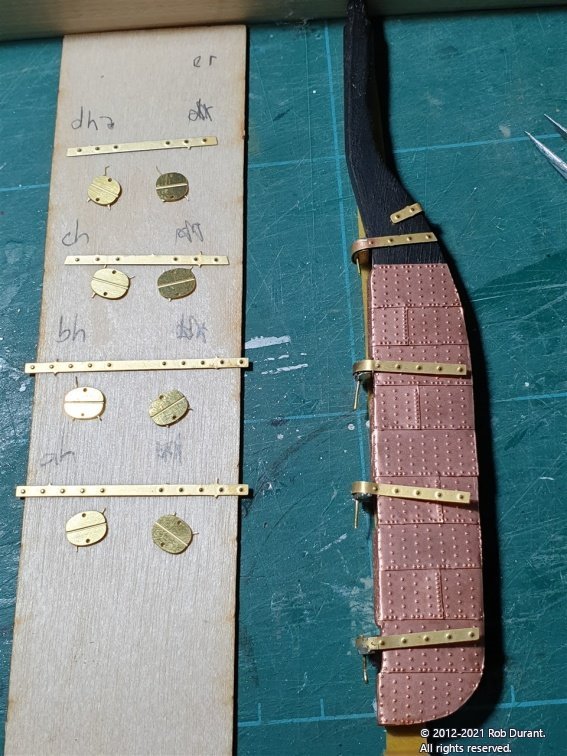
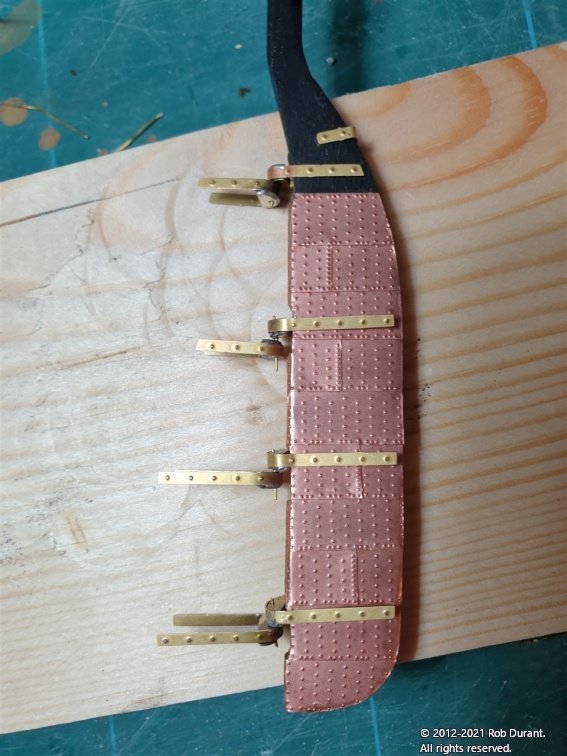
I'm planning to blacken these before I fit them, as I'm not a fan of the brass / copper colour clash. I know that iron and copper don't like each other, so I may paint the pintles and gudgeons below the waterline copper... or I may just go with it, because, hey, it's my model, and perhaps someone painted them black 😁😋
More soon.
Rob
-
Okay... pintles and gudgeons...
MarisStella in their plans have sections where they show all the component parts of one area of the model (e.g. the rudder) laid out alongside each other.
In plan 5, section P19, all the component parts of the rudder are shown... At first glance it seems that there's duplication, but actually when you look more closely it's the pintle components and the gudgeon components. (I was struggling to remember which was which, but the pintle is the one with the pin, mounted on the rudder, and the gudgeon, the one with the hole mounted to the hull).
These components are all labelled neatly on the plans, and those labels are also on the photo-etch fret, so no problems identifying them.
They go as follows:
er is the strap at the top of the rudder (the spectacle plate that provides the mountings for the rudder chains) This will have two eyelets added.
dr, cr, br, ar are the straps, with two associated pieces of photoetch that form the pintles.
The mountings for dr, cr, br and ar have their respective gudgeon partners, dh, ch, bh and ah which will mount on the hull. I decided to start with the pintles on the rudder before cutting out the gudgeon parts.
These are very similar parts, so I was careful to keep a note of which was which. Note that the ends of the straps are designed to follow the stern-most edge of the rudder, so it DOES matter which way up they go. They are the right way up in the photo below.
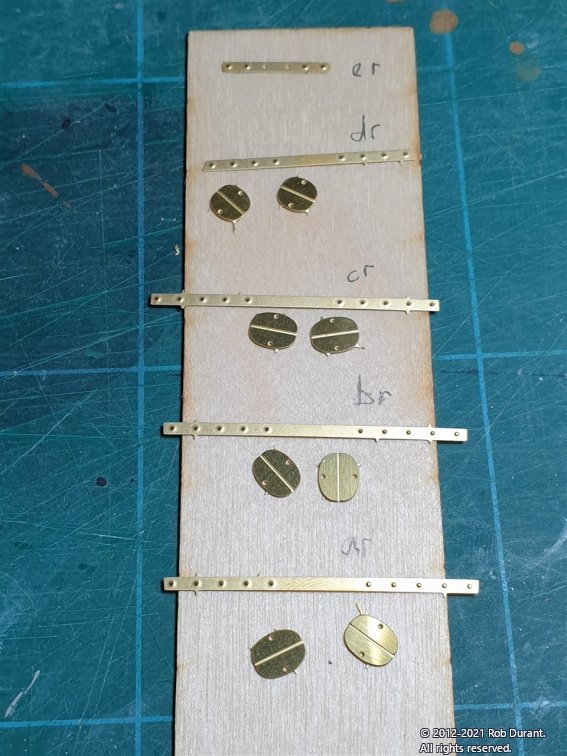
What are the rounded parts? They're the formers that provide shape and support for the front part of the pintle. The instructions are sparse for these parts, but the plans are helpful.
First fold the rounded parts along the line (I would suggest folding with the photo-etched line on the outside.) It's pretty thick metal, so you'll need pliers or similar to do this. Then stack two, one on top of the other and put a length of 0.4mm wire through. I found that mine folded so precisely that there were no problems with the holes lining up, although I did opening them up a little with a 0.5mm drill.
Now they can be soldered together - I used lead, soft-solder - and you should end up with something like this (excuse my soldering... I need more practice, clearly!). It doesn't actually matter how neat the solder looks here as long as it isn't sticking out too much. It's going to be melted again when we add the strap in a minute.
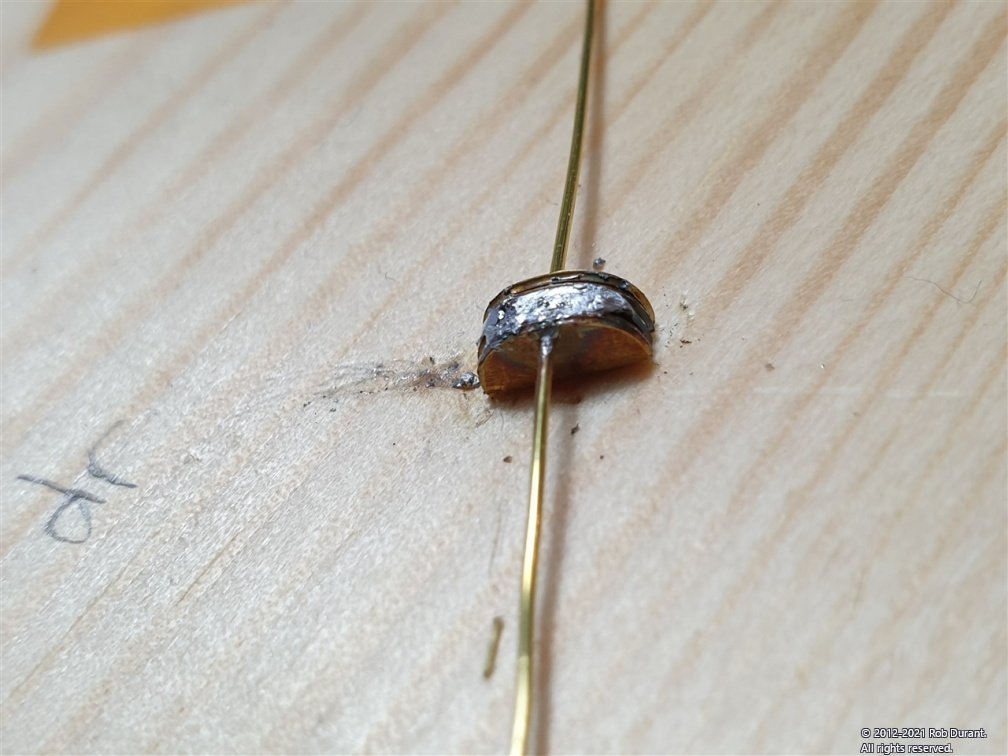
By drilling a .5mm hold into the wood I was using as a soldering board, I could cut the wire so I had about 8mm left on the side that would end up being the pin, and insert it to hold the assembly flush to the board ready for the next step.
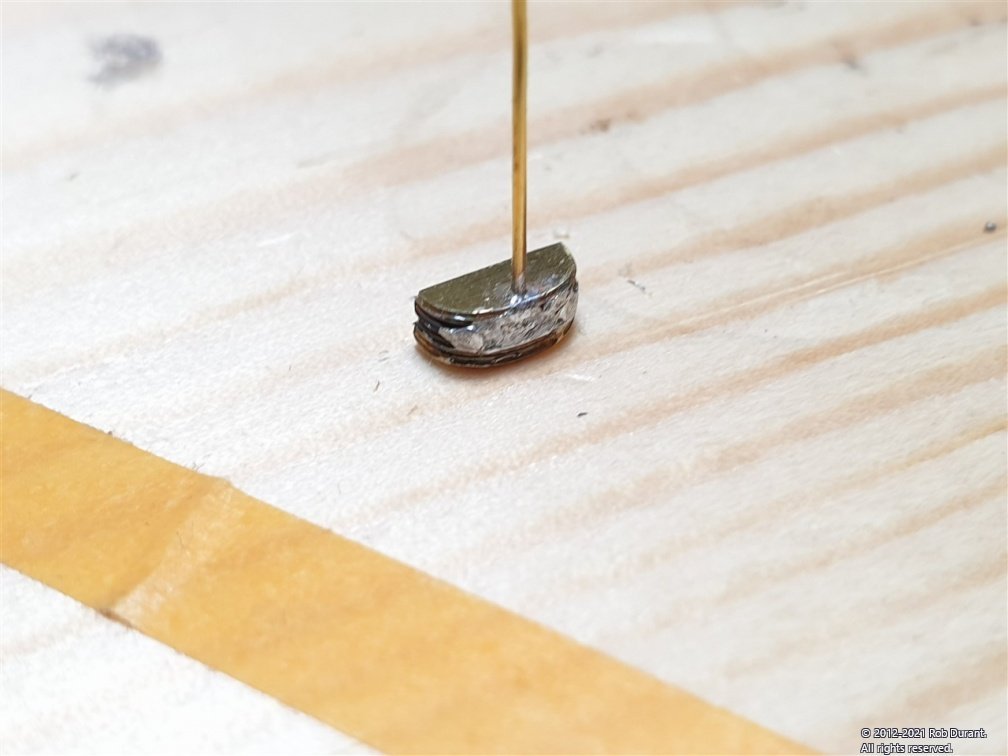
Now the strap is bent round the part to form it into the right shape and soldered into position. Once cooled, you can lift the whole assembly out, and it should look something like the assembly below...
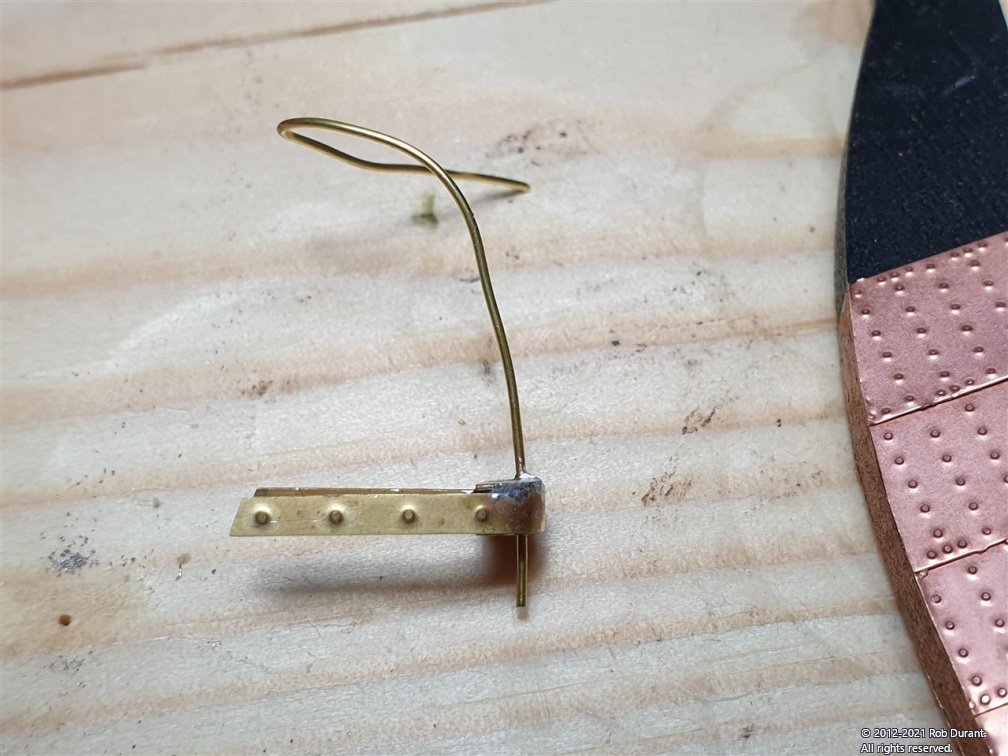
Now - I can't emphasise this enough... do make sure you cut off the right end flush to the assembly, otherwise you'll have the pin going up instead of down (or the straps with the endings facing in the wrong direction), and you'll end up doing it all over again.
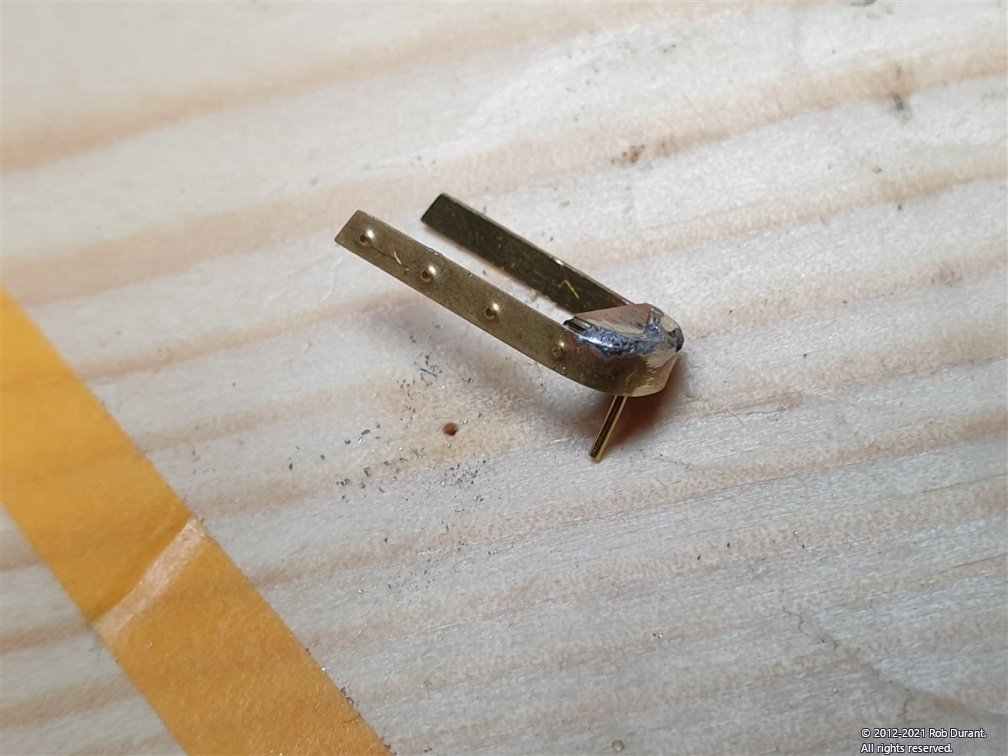
With a bit of clean-up, I think this should look okay.
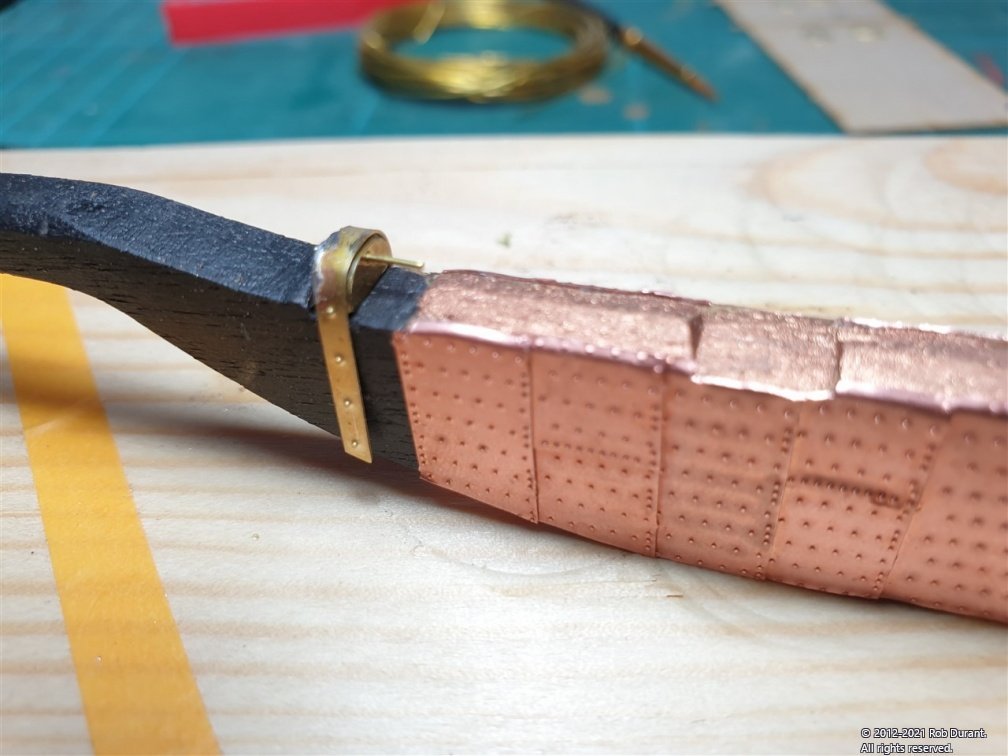
This part was dr, now I need to add the spectacle plate (er), and the three remaining pintles, cr, br and ar, going down the rudder, one in each of the flat areas. I'm waiting to put these in place until I have the gudgeons complete, so I can check the spacing and make sure it all lines up nicely.
That's all from me for now. Hope it all makes sense.
Rob
- dunnock, gsdpic, Keith Black and 5 others
-
 8
8
-
Thank you all for the likes and encouragement
 It's very very good to be back in action again.
It's very very good to be back in action again.
Looking at the plans, I realised I hadn't shaped the front edge of the rudder - nearest the hull - before plating it. With some careful application of a sharp scalpel blade, I was able to carve this wood away, and then wrap the copper round, as it now protruded a couple of millimetres in front of the front edge of side of the rudder.
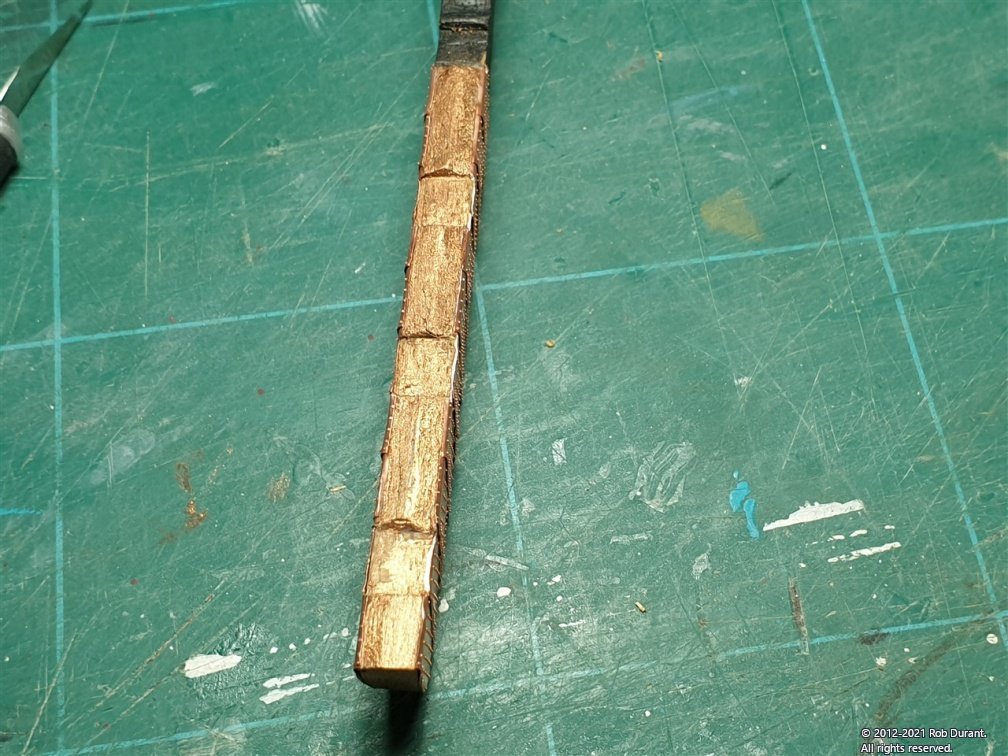
Then I got stuck into making the pintles and gudgeons. But real life calls, and I think that subject deserves a slightly more in-depth post, so I'll write about that tomorrow.
Happy building, all!
Rob
- Rudolf, ccoyle, Keith Black and 2 others
-
 5
5
-
Thank you David, Bob for your kind words, and to everyone for your patience as this build paused. I'm pretty much back to normal now, and work has eased just a little, allowing me time to get re-focussed on Stefano, and back into the shipyard.
I have a little progress to report. I was conscious that I'd coppered the hull, and it was gradually beginning to gain a patina, but I had not coppered the rudder, and I didn't want to end up with a rudder that looked like it had been put on the ship at another time. So, that was the next job.
This was surprisingly tricky to think through, as the tiles overlap from the bottom up, and they need to finish at the perfect point at the top. Equally, I didn't want to have a part tile if I could avoid it. So a bit of measuring, and head-scratching, and lots of pencil-marks later, it CAN be done...
Before I started, however, I removed the laser char from the rudder, and made it wedge shaped, so it narrows from front to back. I think this little touch makes the rear end of the vessel look much more delicate, and I can imagine this would help the hydrodynamic properties of the hull, too, perhaps?
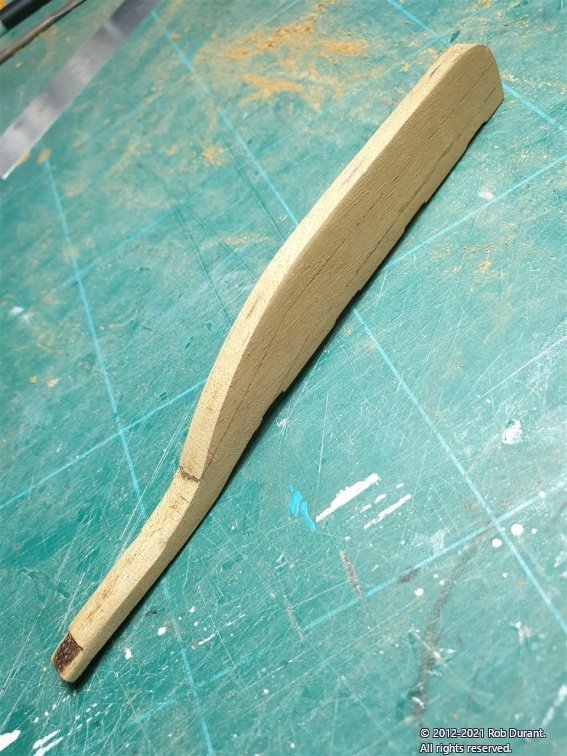
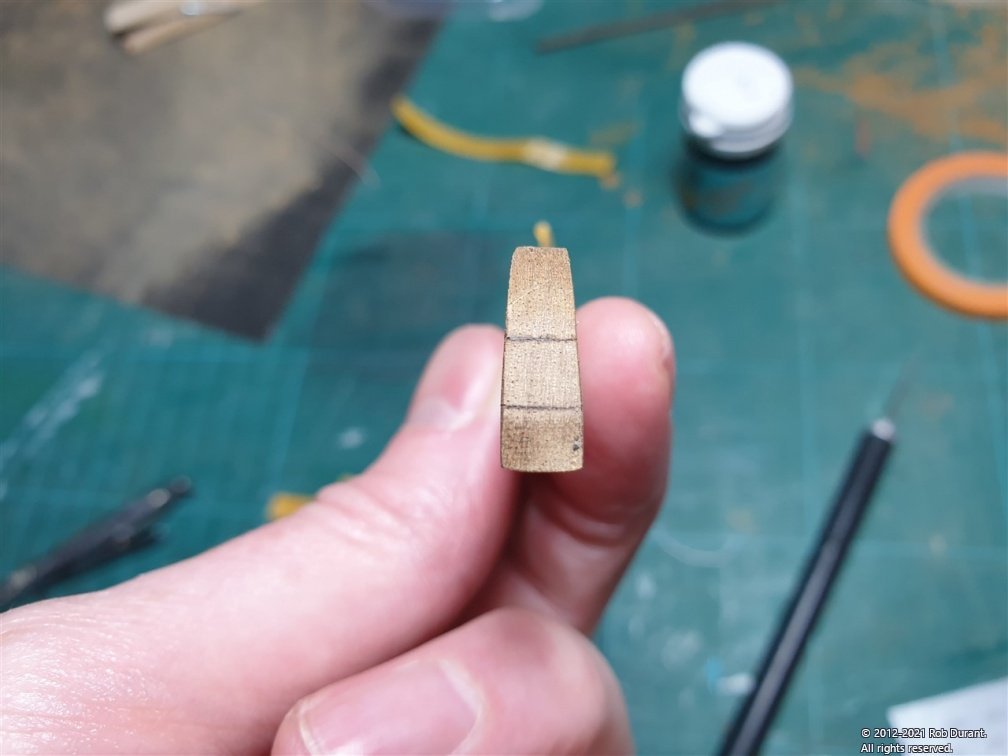
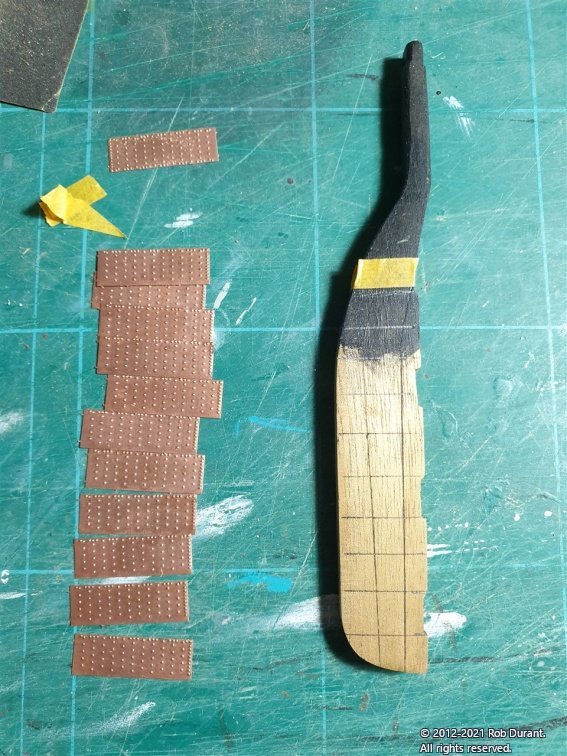
(nb: The tiles are sided - (and in this picture upside-down!) The tiles have vertical rivets at the rear, and the top tile has rivets along the top AND bottom...)
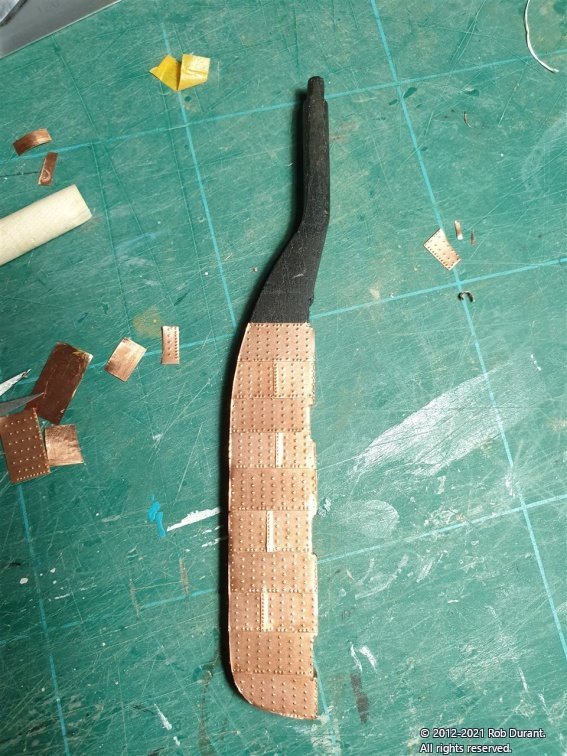
Finally, some copper paint was added on the front and back faces of the rudder, and then it was trial fitted in place...
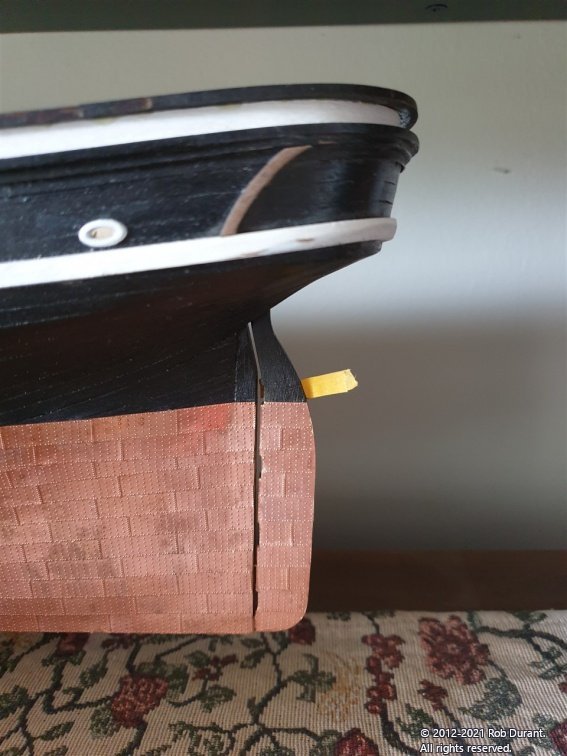
Right - now I need to go and read the manual and work out what I'm supposed to be doing next

Happy building, all!
-
Hi Steve,
I've built both Pickle and Sherborne, and was so glad that I started with Pickle (my first wooden ship build), and THEN went onto Sherborne. The instructions on Pickle are way way way better, consisting of photos, advice, and comprehensive instructions. The instructions for Sherborne are far more brief, and text only alongside the plans. They were okay, but I felt I had to rely heavily on what I'd learned building Pickle. I haven't built Lady Nelson, so I can't advise on that one, I'm afraid.
You can check out the instructions for Pickle on the Jotika website, here: http://www.jotika-ltd.com/Pages/1024768/Manuals_Front.htm , and you'll find lots of build logs on the website here to help you along.
However, as Chris pointed out, the kits that Chris Watton is now designing (for his Vanguard Models company) are another step up in terms of the help they give you to ensure you get to the other end with a model you can be proud of. I'm building Lady Isabella at the moment, and the instructions and kit design are quite amazing. Again, you can download the manuals from his website (e.g. scroll down to the "download manual" link on https://vanguardmodels.co.uk/product/order-zulu-lady-isabella/ ) - and you'll see how far these models have come on since you were building Norske Love.
Regardless of what decision you make, you'll find a lot of friendly help here on this website, so welcome!
Rob
- mtaylor, Ryland Craze, JeffT and 2 others
-
 5
5
-
Hi Dunnock,
Those are looking great! She has teeth now! The walnut(?) carriage parts in my kit of Diana was really flaky, and hard to get a crisp edge with, but you seem to have done an excellent job. The poppy seed is ingenious, too.
The monograms for the guns can be bought separately from Chuck's Syren Model Ship Company, here.
I can highly recommend Chuck's carriages, too but you will find that the height of the assembled guns ends up being different (a little taller) than the provided carriages, which can make lining them up in the ports a little more interesting. I guess that's not such an issue on the quarter deck / fore deck. I would recommend working out the heights one by one as you fit them, then fixing the quoins in position, having sighted along the row of barrels to ensure you get a really nice sweep. Definitely one of the show-pieces of these models!
Rob
-
She's looking wonderful. You're doing a lovely job of building this kit. The headworks look very sleek and precise.
-
I haven't given up on this build but coronavirus stepped in and I'm still not quite back to the stage where I can get my work done and have energy for Stefano at the end of the day
 getting better each day though.
getting better each day though.
More soon hopefully. But first I have a holiday for a few days.
- egkb, Keith Black, ccoyle and 2 others
-
 5
5
-
-
-
Rob, You my have answered this question before, in which case I apologise, but what is the material that you're using to make the cabin sides? It seems that you are able to score it to mark the panel lines? Certainly, the effect is very convincing.
-
And after a while you can look back and say... "it may be wrong, but it's less wrong than it used to be."
A fascinating and very skillful build and build log. Thank you for sharing this learning and growing process with us.
- Baker, mtaylor and Edwardkenway
-
 3
3
-
James posted this in the sister thread (Nisha) "All I currently require for this one is the photo-etch and sails" on Sep 8th, so I'd think yes.

- thibaultron, chris watton and EKE
-
 3
3
-
What an ingenious solution for fixing the mast. She's looking great.
Rob
-
-
If the original ship ever looked anything near as splendid as your model, what a vessel she must have been!
Wonderful work!
- Hubac's Historian, mtaylor, EJ_L and 2 others
-
 5
5
-
Thanks Bob, Jobbie. Hopefully have some more progress to show soon.
-
And the port side is now plated as well. Just the line along the keel and up the bow, and the rudder to plate now, but I shall take a breather first.
I had to slightly sand the notches in the display stand to make space for the copper tiles which make the keel marginally wider.
A couple of pictures, one of which shows the Vanguard Models Zulu "Lady Isabella" for size comparison... Both are almost identical scale (1:64 for the "Lady Isabella", to 1:63 for "Stefano")
I have to say, as much as these copper plates are brilliant, I shalln't be sad to have a break from sticking them on individually for a while!
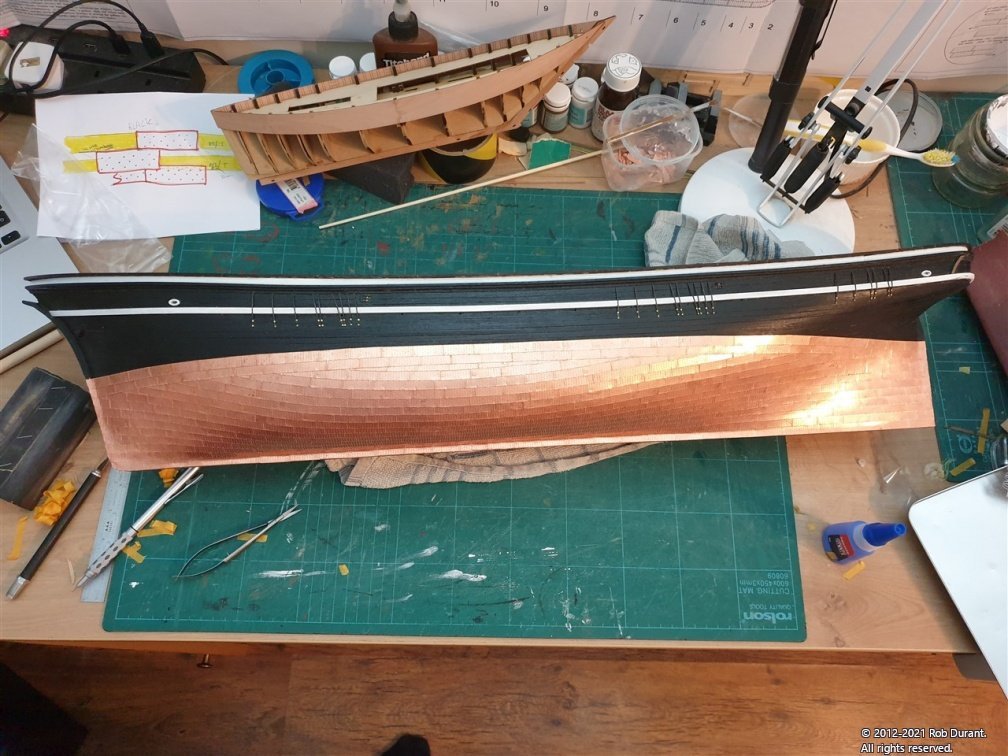
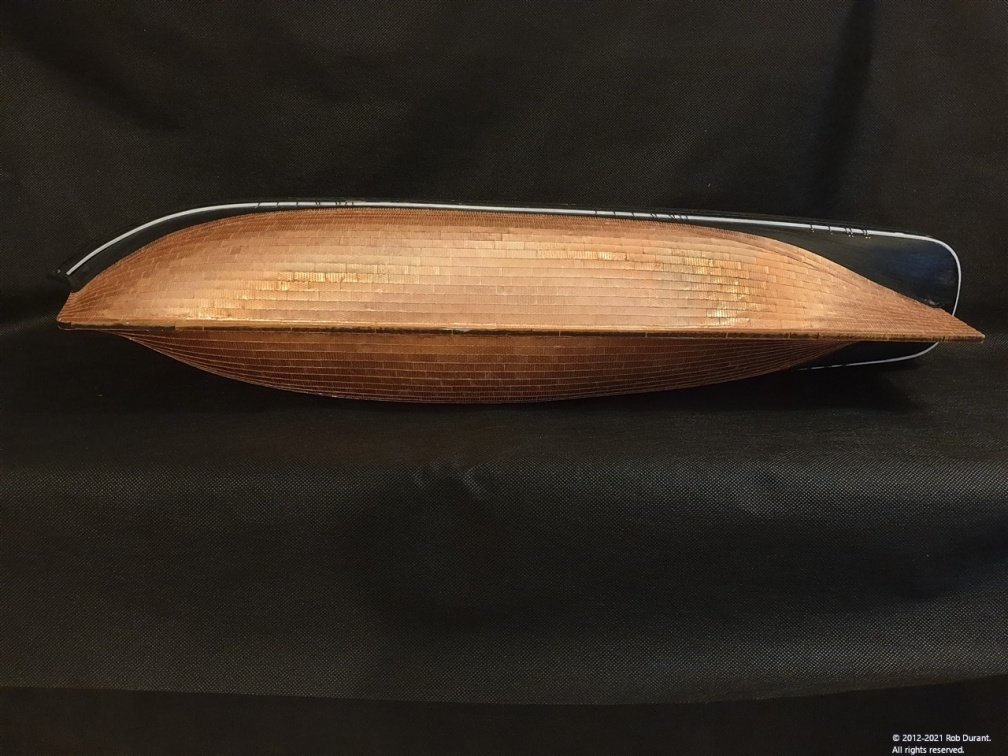
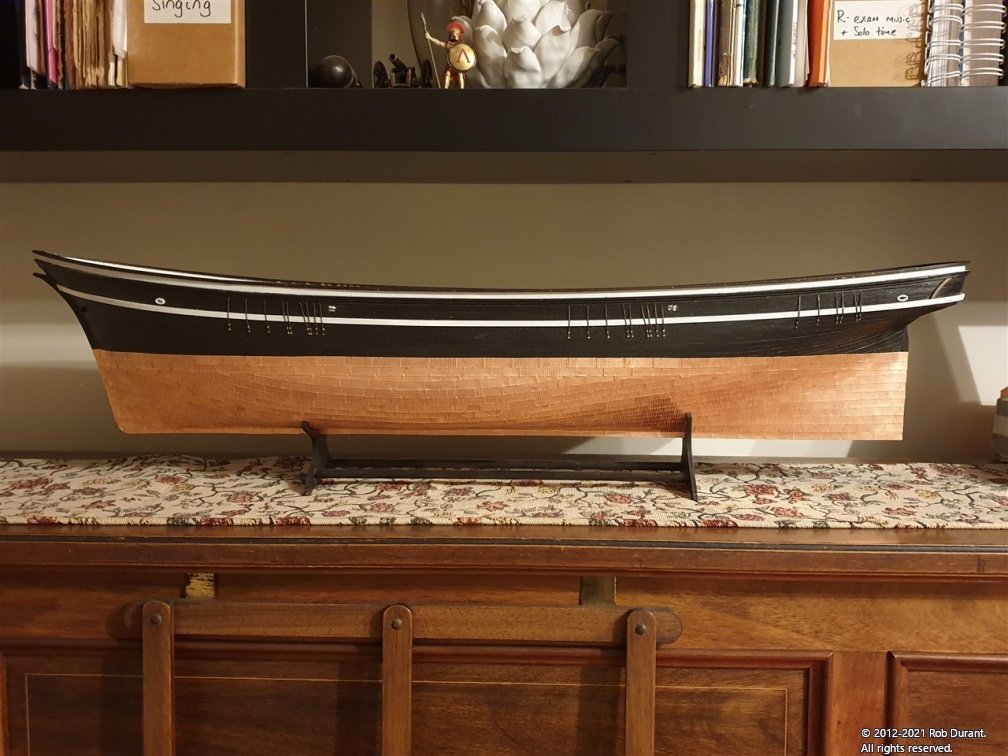
-
-
6 hours ago, GrandpaPhil said:
Congratulations! Nicely done!
Thank you
 I look back at her now and can't quite believe I built her! A testament to the excellent kit design and great encouragement, ideas and resources on this site!
I look back at her now and can't quite believe I built her! A testament to the excellent kit design and great encouragement, ideas and resources on this site!
- GrandpaPhil and Keith Black
-
 2
2
-
Jason,
What beautiful work you're doing on the quarterdeck. Any captain would be proud to wear those planks thin by pacing them on the weather-side!
Rob
-
Thanks for all the likes and encouragement.
I thought it might be helpful to some if I described in a little more detail how I'd planned out the bands along the top of the plating, when the plates are all laid from the keel up. It presents an interesting challenge, because the shaped tiles must be laid first, then the bands along the top which overlap them. All must be done leaving enough space for the top plates to overlay the lower, and leaving a smooth waterline, and without too much distance between the plating below the bands, and the waterline so that messy gaps are left. In addition, one can't simply leave full tiles underneath the top bands as they have raised rivet detail which will raise them unevenly. Hence they must be trimmed. I wondered whether I might hammer down the detail, but I was unconvinced that I'd manage to do that on the rivets in question without completely destroying the visible area of the tiles.
Here's how I managed it. I measured the width of the bands at the top, and marked that width down from the waterline minus two millimetres. That gave me the line I wanted the plating to finish at below the bands. Once the lower plates reached that line they are now being cut to follow that line. The lower band can then be started overlapping those plates slightly, and leaving 6mm for the upper band.
Hopefully that makes sense. At each sense, I'm making sure I'm measuring again carefully and checking as I go. I'm using 6mm masking tape to keep a nice neat space for the top band (which are the tiles with rivets on the top AND bottom) to finish off. This should, hopefully result in a nice neat line. The waterline painted will be the guide for this.
Here are the results so far...
The first photo shows the lower plating cut to the pencil mark (which shows the bottom extent of the two bands, minus the overlap). The first two plates of the lower of the two top bands have been added, with the yellow masking tape giving a guide to make sure sufficient room is left for the top of the two top bands.
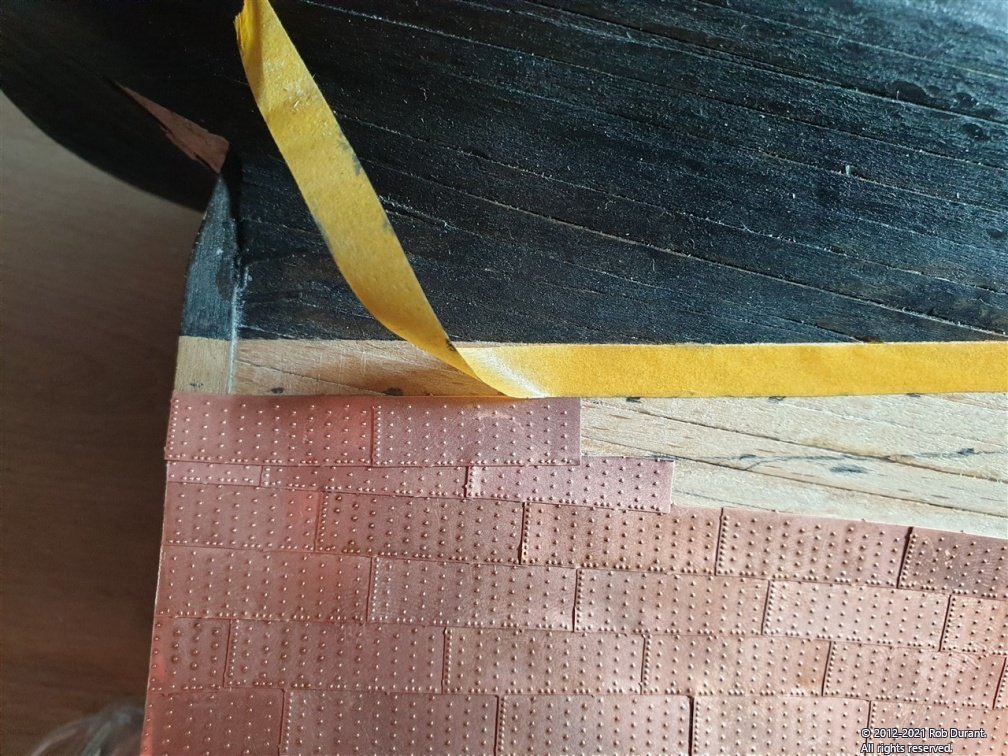
The second photo is the same work but from the stern to show the sweep as it goes forward.
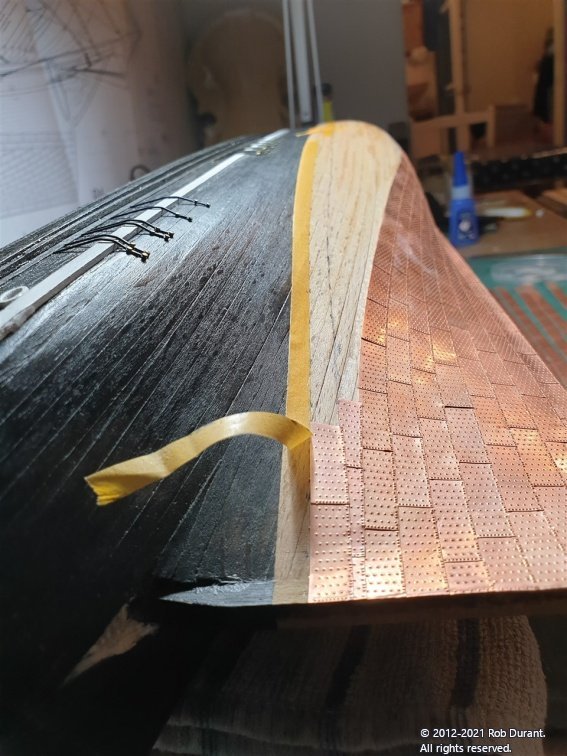
And a couple of angles of progress so far.
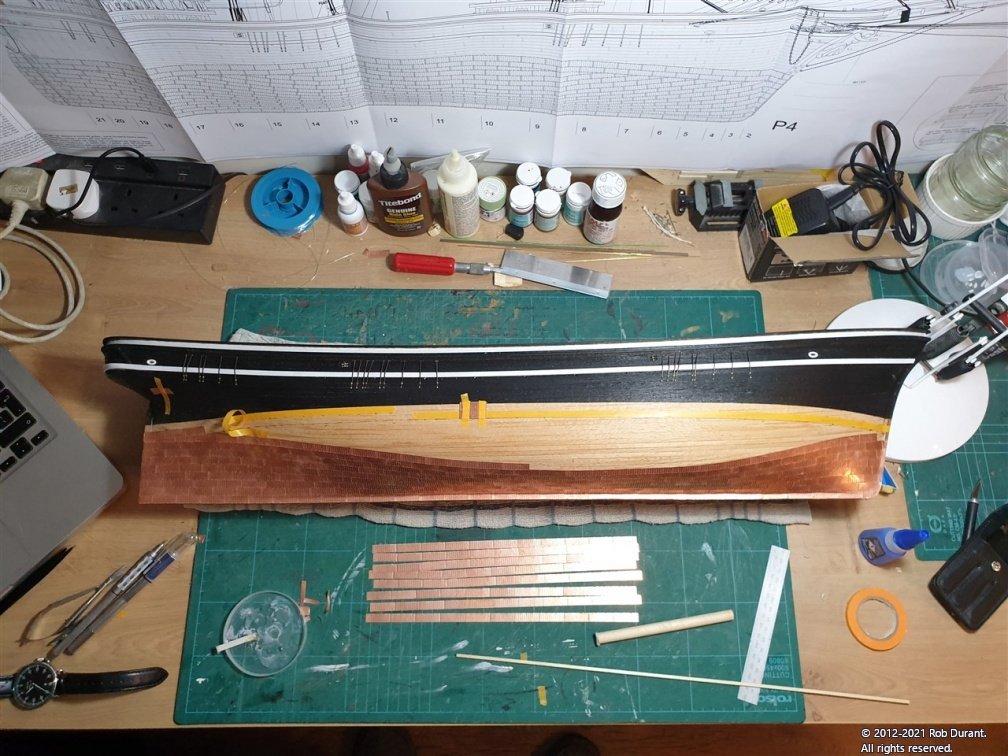
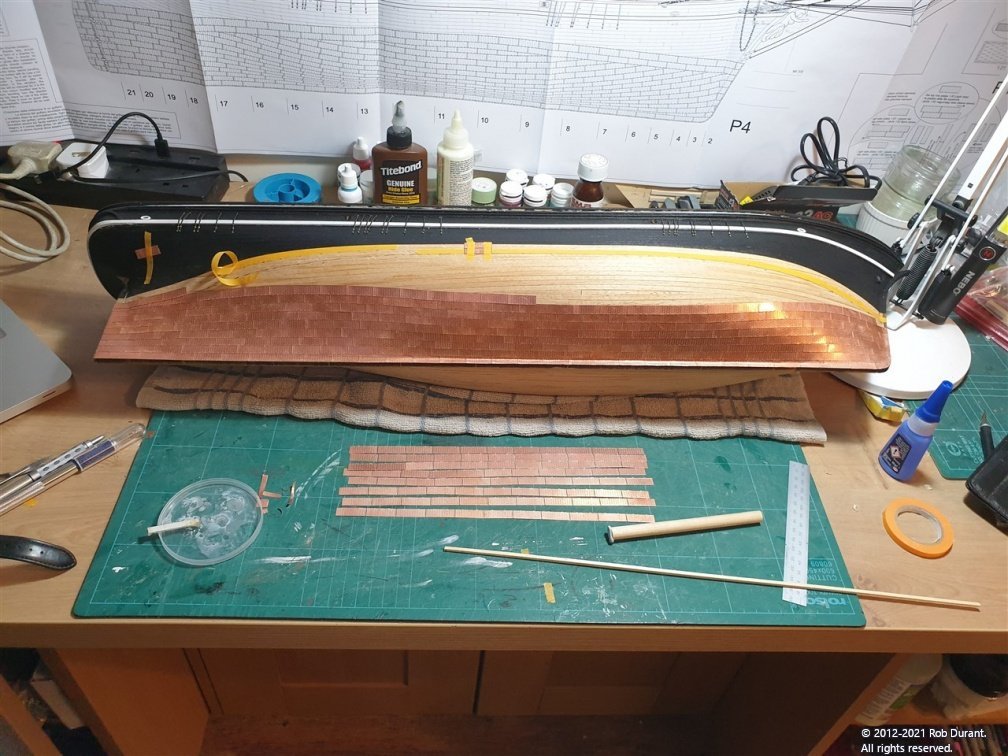
These plates are quite simply cut where necessary with little scissors, so with a little care the job is proving relatively straightforward. I've also realised that the photo etch tags can be easily cut with a scalpel to remove them from the main sheet without any bending. So that's now my preferred method of doing that. Once done, they are then trimmed and separated with tiny sewing scissors.
Happy building!
Rob

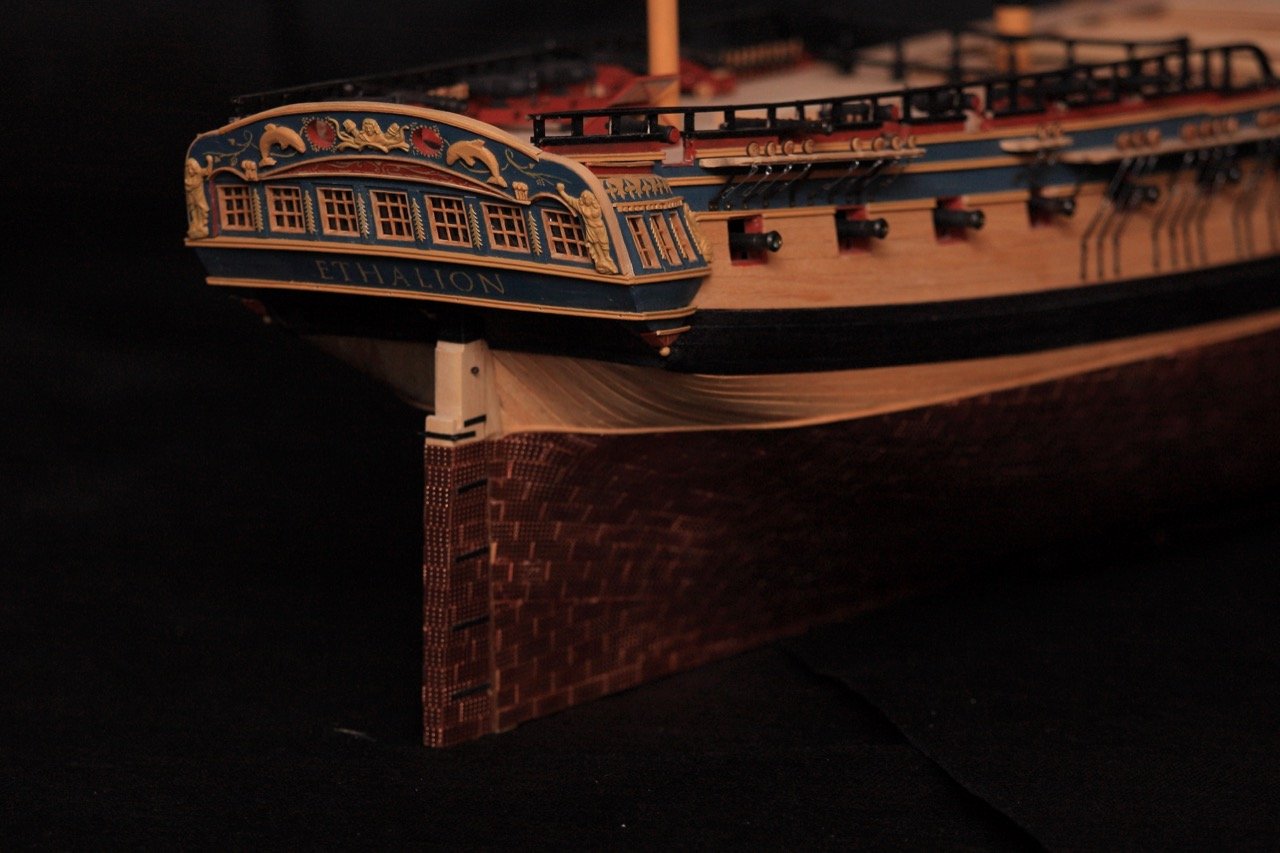

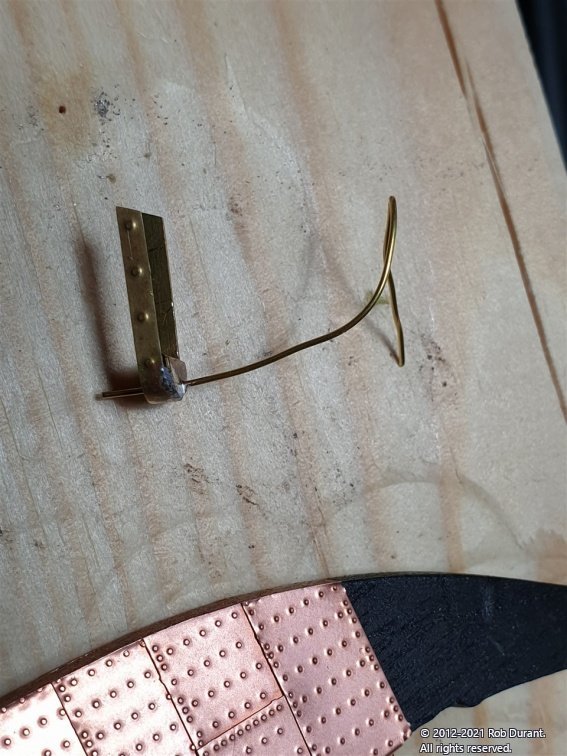

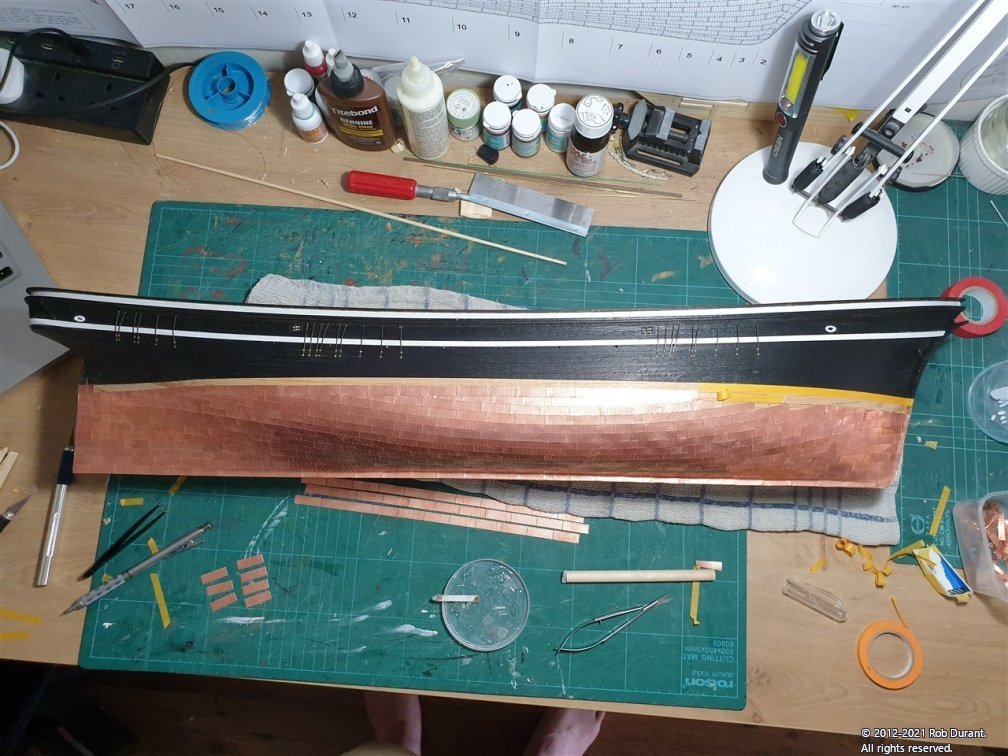
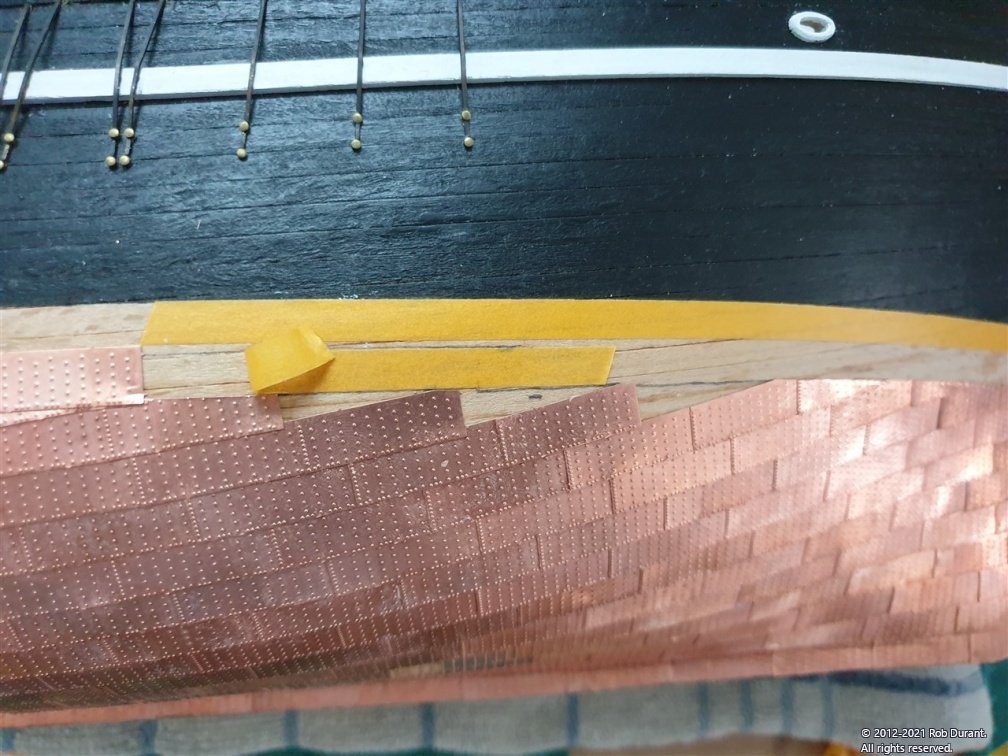
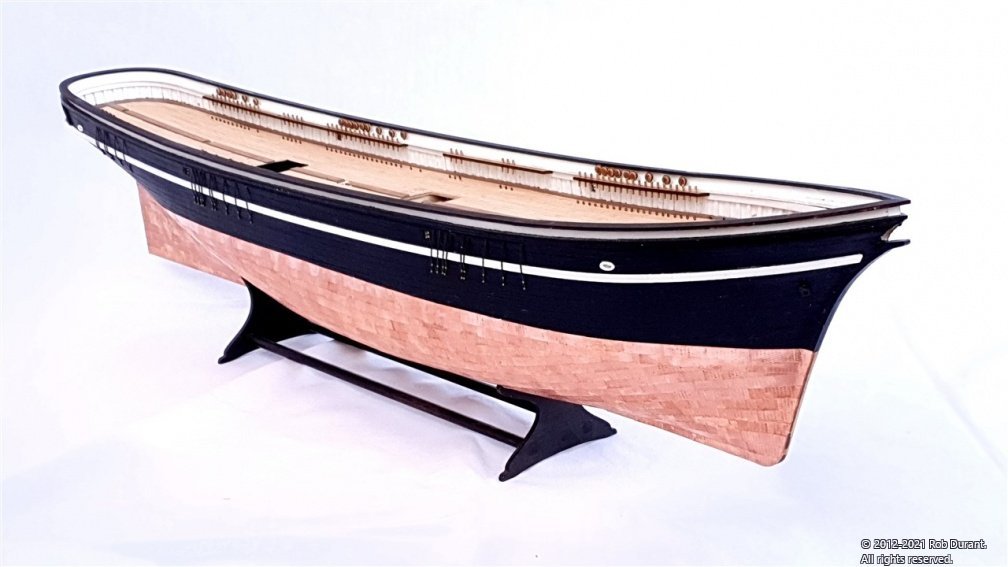
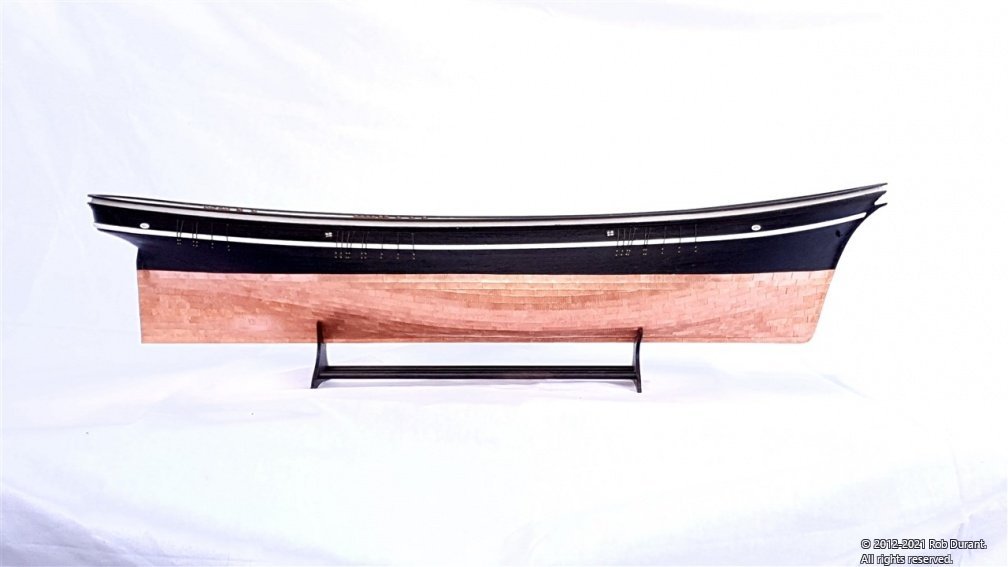
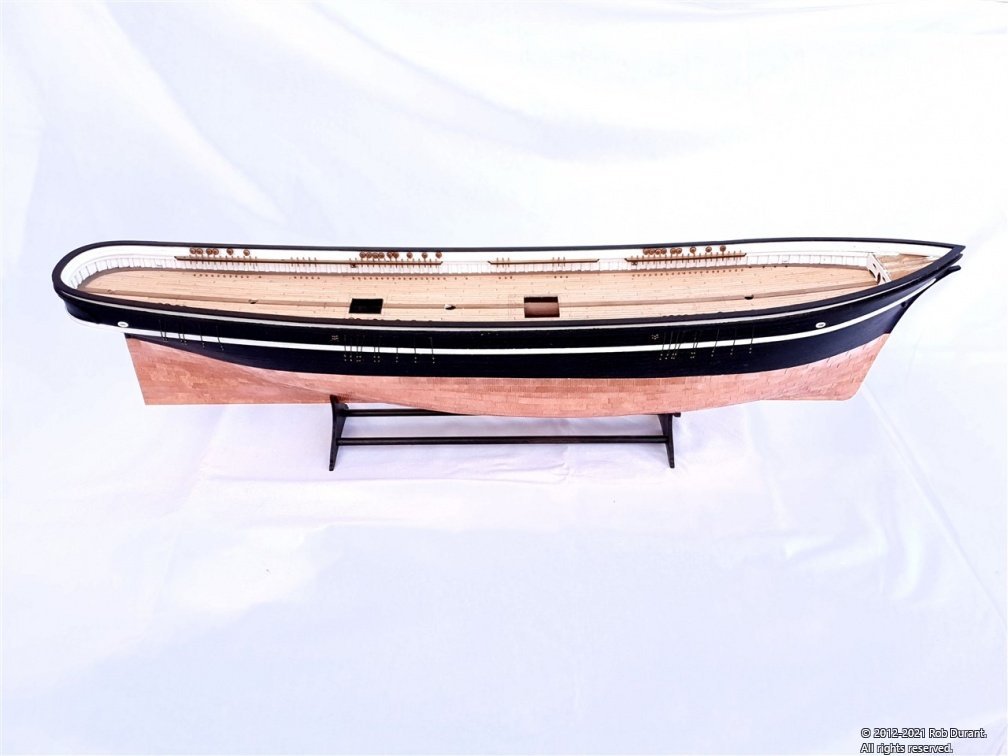

Barque Stefano by robdurant - MarisStella - 1:63
in - Kit build logs for subjects built from 1851 - 1900
Posted
Hi all, and thank you for the likes,
I've made up the tiller. This is made up of six parts. Three wooden, and three metal.
First is to find the tiller parts - marked as 46 - on the laser-cut sheets. One part is on a4mm sheet, and the other two on the 2mm sheet, but all are very well marked.
These are glued together as shown, leaving a gap for the rudder post. The parts glue like this...
And can then be marked up for the front to back taper..
And the extra cut back...
A test fit meant cutting down the rudder post to size (approx 3.8mm square).
Now the photo-etch detailing can be added to the tiller, along with two eyelets (I reused some eyelets I had left over from a previous model, because they were already blackened, and readily available, but there are eyelets provided on the photo-etch sheet. What I couldn't tell was whether there were any assigned for this particular task - there didn't seem to be any specifically marked 46 (for this stage).
Here it is with the photo-etch in place... This is _very_ zoomed in - it looks much more tidy to my eye in person, if a little heavy for scale? The part is etched to help with the bending, but this means it is full depth, rather than the half depth of the pintles and gudgeons (which were etched back to give the rivet detail).
I'll see if I can live with it, and if it starts to irk me, I'll replace it with card, painted with Tamiya dark iron... instead.
I've also put the eyelets onto the spectacle plate ready for the rudder chains...
And blackened one of the 1mm chains (3x 1m lengths are provided in the kit) ready to install.
And I've started working out how to form the shackles - the smaller of the two sizes provided - which are tiny, indeed. I found cutting the excess brass away from these parts quite tricky, and you can see the remaining on the part below. Filing it is, from what I could tell, almost impossible as they are so delicate. Perhaps I could use a sharp knife and a solid surface instead. More practice is required, evidently!
The following photo gives some idea of the size...
Linked together, and awaiting solder, it looks something like this...
I've yet to see if I can solder this... it may pleasantly surprise me, but I ran out of time today
More soon! In the meantime, happy building to you all.
Rob